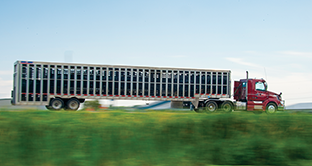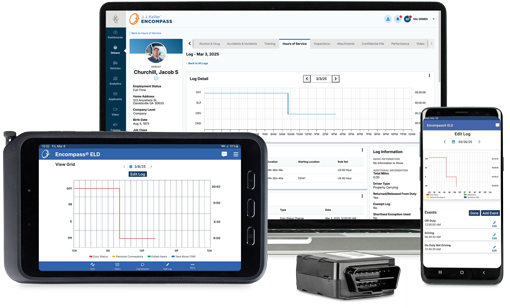Sr. Transportation Management Editor — J. J. Keller & Associates, Inc.
Hours of Service Guidance for Ag Haulers
Updated guidance from the FMCSA allows agricultural commodity transporters greater flexibility.
Published On: 02/28/2024


Written by:
Mark Schedler
This article was updated on 2/28/2024.
On November 24, 2020, the Federal Motor Carrier Safety Administration (FMCSA) clarified its definition of agricultural commodity related to federal hours-of-service (HOS) exemptions. The Interim Final Rule (§395.2) is effective December 9, 2020.
Updated guidance from the FMCSA allows agricultural commodity transporters greater flexibility for using the hours-of-service exemption in 49 CFR 395.1(k)(1) when their vehicle is empty or when traveling to multiple loading points. Specifically, drivers transporting agricultural commodities during the state's planting and harvesting season are entirely exempt from hours-of-service rules, including the requirement to use an electronic logging device (ELD), if they stay within a 150-air-mile radius of the source of the commodities.
Key Definitions
The following terms have been changed under the new guidance and are worth reviewing:
Agricultural commodity now means 1) "any agricultural commodity, food, feed, fiber, or livestock," and 2) "Any agricultural commodity" means horticultural products at risk of perishing, or degrading in quality, during transport by commercial motor vehicle, including plants, sod, flowers, shrubs, ornamentals, seedlings, live trees, and Christmas trees.
Livestock now means livestock as defined in sec. 602 of the Emergency Livestock Feed Assistance Act of 1988 [7 U.S.C. 1471], as amended, insects, and all other living animals cultivated, grown, or raised for commercial purposes, including aquatic animals.
Non-processed food was added to the list of definitions. It means food commodities in a raw or natural state and not subjected to significant post-harvest changes to enhance shelf life, such as canning, jarring, freezing, or drying. The term includes fresh fruits, fresh vegetables, and cereal and oilseed crops, which have been minimally processed by cleaning, cooling, trimming, cutting, chopping, shucking, bagging, or packaging to facilitate transport by commercial motor vehicle.
The Requirement to Use an ELD
The guidance did not change the requirement for agricultural commodity haulers to be subject to the hours-of-service regulations and the electronic logging requirements when outside of the 150 air-mile radius.
An electronic logging device (ELD) is required to log when hauling agricultural commodities outside of the 150 air-mile radius if the driver has logged more than eight times in any rolling 30-day period. However, there are a few exceptions to using electronic logs.
Exemptions include:
- Drivers hauling livestock and insects, regardless of distance (per FMCSA, exempt until further notice)
- Drivers operating a vehicle older than model year 2000 (per the vehicle identification number (V.I.N.) on the registration) and containing the original engine
- Drivers operating a vehicle with an engine model year 1999 and older, regardless of vehicle model year
- Drivers who have logged eight or less times in any 30-day period
In addition, the 30-minute break from 8 hours of driving does not apply to drivers transporting livestock in interstate commerce while the livestock is on the commercial motor vehicle.
Interpretations for Ag-Commodity Haulers Only
The new guidance allows drivers to use the exemption when traveling empty to or from the source, better defines what is considered "the source," and clarifies that drivers may use the exemption during the first 150 air-miles (172 statute or "road" miles) of a trip that delivers outside of the 150 air-mile radius.
Note: The guidance below only applies to the transportation of agricultural commodities in §395.1(k)(1) and does not apply to farm supplies or equipment for agricultural purposes. Therefore, §395.1(k)(2) and (3) are not affected by the new guidance.
The guidance reads as follows:
Question 34: Does the agricultural commodity exception (395.1(k)(1)) apply to drivers while driving unloaded within 150 air miles of the place where an agricultural commodity will be loaded, and to that portion of an unloaded return trip which occurs within a 150 air-mile radius of the place where the agricultural commodity was loaded?
GUIDANCE: Yes, provided that the trip does not involve transporting any non-agricultural cargo and the sole purpose of the trip is to make a pick-up or delivery of agricultural commodities, as defined in §395.2. In that case, driving and on-duty time are not limited, nor do other requirements of 49 C.F.R. Part 395 apply.
Question 35: Does the agricultural commodity exception (395.1(k)(1)) apply if the destination for the commodity is beyond the 150 air-mile radius from the source?
GUIDANCE: Yes, the exception applies to transportation during the initial 150 air-miles from the source of the commodity, regardless of the distance to the final destination. Once a driver operates beyond the 150 air-mile radius of the source, 49 C.F.R. Part 395 applies. The driver is then subject to the limits under the hours-of-service rules and must record those hours. Once the hours-of-service rules begin to apply on a given trip, they continue to apply for the duration of that trip, until the driver crosses back into the area within 150 air-miles of the original source of the commodities.
Question 36: How is the "source" of the agricultural commodities in §395.1(k)(1) determined?
GUIDANCE: The "source" of an agricultural commodity, as the term is used in §395.1(k)(1), is the point at which an agricultural commodity is loaded onto an unladen commercial motor vehicle. The location may be any intermediate storage or handling location away from the original source at the farm or field, provided the commodity retains its original form and is not significantly changed by any processing or packing. If a driver is making multiple trips, the first trip, and the 150 air-mile exception around that source, terminate once all agricultural products are offloaded at a delivery point. A new source for a new trip may then be identified, and the 150 air-mile radius for the exception will be around that source.
For example, a sales barn where cattle are loaded may be treated as a "source," in addition to the location at which they were raised, since cattle remain livestock. As another example, a place where heads of lettuce are stored may become a "source," provided they retain their original form. An elevator where grain is collected and dried may be a new "source," again assuming that the grain is not milled or similarly processed at the elevator."
Question 37: How is the "source of the agricultural commodities determined if the driver makes multiple pick-ups of the commodity en route to the final destination?
GUIDANCE: When a driver loads some of an agricultural commodity at a "source" and then loads more of that commodity at additional stops, the first place where the commodity was loaded is the measuring point for the 150 air-mile radius.
Comply with HOS Exemptions with J. J. Keller® ELDs
The Encompass® ELD app makes compliance with hours of service easier for your drivers, mechanics, and other employees with exempt driving rulesets and quick ELog annotation entry to document exceptions that impact their record of duty status. Talk with a compliance specialist today about the Encompass® ELD app.
Hear from Our Experts!
Watch this episode of the DOT & ELD Regulatory Minute for guidance from J. J. Keller regulatory experts. Subscribe to our YouTube channel for the latest compliance & safety insights!
You may also enjoy the following articles:
Sign up for our newsletter!
We'll help you stay on top of regulations, best practices, and fleet industry news. Sign up to receive a monthly email notification with links to our most recent blog articles, free resources, and event invites.
